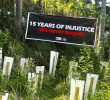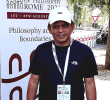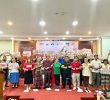Lawyer Atty. Antoinette Principe, who represented the Davao chapter of the Integrated Bar of the Philippines (IBP), urged the proper authorities to check to see the extent of the abuses the military. “Why would (the respondents) make up stories?” said the young lawyer, who also works for the Integrated Gender & Development Division (IGDD).
Education department regional chief Dr. Susana Estigoy, suggested that a research should also be made on the experiences of government soldiers in the field.
According to Ugay, ‘Uncounted Lives’ does not only present to us the travails of the victims but rather the harsh realities of their daily life, be they at war or at peace.
In its summary, Ibon noted a high poverty incidence in areas with armed conflict. Ibon also noted a scarcity of educational and health facilities and limited access to electricity.
Ibon also noted how women of Central Mindanao, who have been forced to leave their homes quite frequently, systematically relate their poverty to the current armed conflict. For them, displacement results in the loss of economic capital and difficulty in finding livelihoods, says Ibon. These same women also blame armed conflict and their consequent evacuation for problems in their children’s education and health. For one, educational infrastructure in the communities also sustained significant physical damage.
But armed conflict is not solely the reason for these miseries, the Ibon book pointed out. In the case of education, for example, lack of funds was the biggest factor why children had to stop their studies. According to ‘Uncounted Lives’, the percentage of out of school children in places where there is armed conflict is similar to the percentage of out of school children in places where there is none.
Many internally displaced Moro children, however, say that their birth certificates and other documents were destroyed when government soldiers burned down their homes, blaming the loss of these documents why they had to stop going to school.
Nahla, 11, of Maguindanao said she and her eight year old sister had not been able to re-enroll because their school report cards and birth certificates were among the many things they lost when the soldiers burned down their home. Children from North Cotabato also recall bullet holes in the Philippine flag and the damage to their classrooms, making them unusable.
The Department of Social Welfare and Development (DSWD) pegs the number of internally displaced persons to reach 1.02 million in 2001-2005. Almost 70 percent of these IDPs come from the Autonomous Region in Muslim Mindanao, which include the provinces of Basilan, Lanao del Sur, Maguindanao, Sulu, Tawi-tawi and Sharif Kabunsuan and region nine which covers the provinces of Zamboanga del Norte, Zamboanga del Sur, Zamboanga Sibugay.
Ibon believes that the lament of Moro children over the perpetual interruption in their studies is also an appeal for a return to daily routines and some stability in their lives. Fourteen-year-old Jomar depicts their leavetaking in his drawing during a focused group discussion conducted by Ibon. He shows a tank just beside a house while a large helicopter hovers overhead and people file out of their community carrying bags.
‘Uncounted Lives’ features many other similar illustrations, including drawings of soldiers shooting at mosques and houses in the conflicts that occurred in 2000, 2001 and 2003.
These drawings and pictures offer a more concrete glimpse of the children’s experiences with armed conflict in their communities.
A 15-year-old boy’s drawing showed the chronology of the war from 1998 to 2003. According to him, they were happy when there was no war. They were not scared. He also recounted that many died in evacuation centers in 2000; that many civilians died in 2001 as former President Joseph Estrada continued the all-out war; and that President Gloria Macapagal-Arroyo also attacked their communities in 2003.
Ugay said she hopes the book will put a stop to the armed conflict. She also hopes that the quality of life of the people will improve in the countryside, where most of the conflicts occur.
Estigoy was worried that the experiences of the children featured in the book will remain with them throughout their lives.
Aside from the Unicef, funding for the research and publication of the book came from the European commission office of humanitarian aid, the AusAid of the Australian government, and the Canadian International Development Agency.
Davao lawyer Faye Risonar said the book is an unwitting tribute to the strength of women in the communities where the conflicts take place.
The book is available in Kyabaan alternative book store in front of the Matina campus of the University of Mindanao and other outlets where Ibon books are found. (CJ Kuizon/davaotoday.com)










